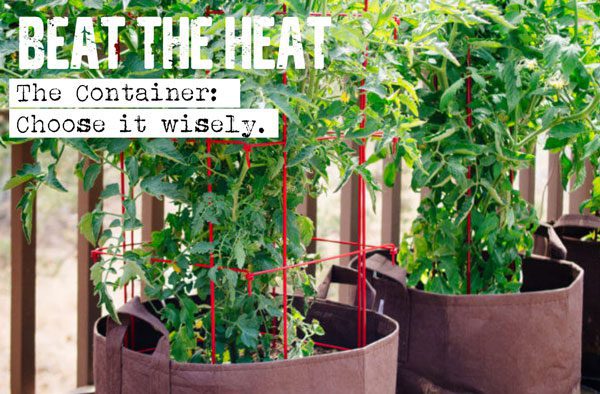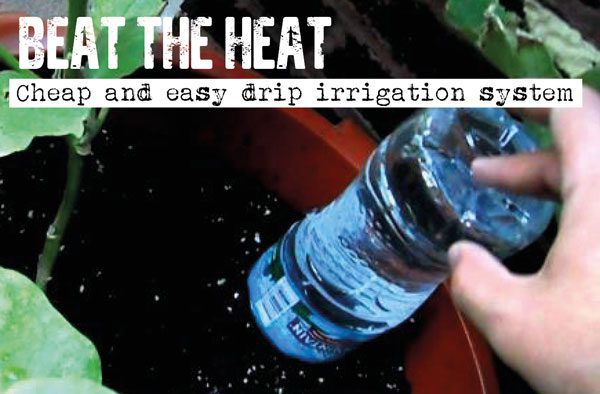We’ve hit the dog days of summer, which makes keeping anything planted in pots or tubs a real challenge. To make matters even more difficult, some locations have water restrictions! There are a few things you can do to help your container-grown vegetables survive the heat.
The Container

Choose it wisely. It could mean the difference between harvest and a total loss.
- Don’t use dark-colored containers because the plant’s roots get hotter and dry out quicker than they do in light-colored ones.
- Allow room for some moisture retention. This trend to recycle anything that will hold earth is great, but a big plant in a small container needs more water than a small plant in a large container. Cramming a cherry tomato plant’s root structure into a recycled juice can will not work. How is the plant supposed to deal with the heat in such an unbalanced environment?
- Container material can make a big difference. That tin can we were just talking about? Well, metal of any color baking in the sun gets really hot! Consider the hood of a car after it’s sat in a parking lot all day. Even if it’s white it’s hotter than hell, and if you hose it down the water evaporates in minutes.
Look for thicker plastic or resin. Don’t grow in black nursery pots – they’re designed for use under timed sprinkler systems in a commercial setting.

Wood will give your plant’s roots some insulation against the heat, as will glazed ceramics. Terracotta clay pots dry out super fast due to air through the sidewalls when you’re growing in potting mix.
The perfect vegetable gardening container is a fabric pot. Smart Pot, Geo Pots, or recycled grain bags (the woven plastic kind) allows you to grow in regular soil, which retains moisture far better than any potting mix. Your veggies will be far happier in these than any other kind of pot, and you won’t need to water every day either if you’ve used topsoil. You can even mix in quite a bit of heavily composted manure in these.
Better Moisture Retention

- One thing you can do to help keep roots hydrated longer per water application is lightly mulching the surface of your potting media. Remember, you still need some airflow. Don’t make it too thick, perhaps 1/2″ of shredded bark or paper.
- Mix a little bit of dirt into your potting mix when you’re planting the container garden in the spring. Unless it’s heavy clay or some play sand, topsoil will boost the length of time that moisture remains near the plant’s roots.
Moisture Delivery

- Don’t water the leaves – water the soil. This is true in any kind of garden. The plant’s roots need the water – not the above-ground portions.
- If you’re on water restrictions because of drought, use a watering can instead of the hose. It gives you far greater control over where the water gets deposited, allowing you to be more frugal without losing plants.
- Set up a drip irrigation system. You can make it complex or very simple depending on your skill level and budget. The fast, cheap, and easy drip irrigation system is a 1-liter drink bottle with a single hole drilled in the lid that is filled and then inserted into the soil. It only drips out when the water table in your container drops enough to release natural pressure. Your pots will stay hydrated much longer with this deep watering technique.
- Self-watering pots can help, but they can also add unwanted problems from the anaerobic activity in the reservoir due to no airflow (bacteria love to grow there, especially when it’s really hot).
- Water in the morning. More of the water will soak in when the temperature is cooler. The higher the sun climbs, the hotter the surface of the soil will be and the more water you lose to evaporation.
Hopefully, enough rain will arrive before restrictions ban watering vegetables too. You can use some recycled water for watering vegetables, either from a rain barrel or the leftovers from boiling eggs, vegetables, or pasta. If you hand wash dishes, capture the rinse water.
The amount of thought and planning you put into your container veggie garden at planting time can make a big difference in how well it does in a heatwave!
Last updated by Catherine Sherriffs on 20/07/2020.